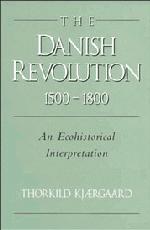Book contents
- Frontmatter
- Contents
- List of Illustrations
- Figure 1 The Danish States: Denmark, Norway, and Schleswig-Holstein in the eighteenth century
- Preface
- Figure 2 Denmark in the eighteenth century
- The Danish Revolution 1500–1800
- Introduction
- Part I Denmark, 1500–1750: A Country in an Ecological Crisis
- Part II The Ecological Revolution
- 3 The Green Revolution
- 4 The Energy and Raw Materials Revolution
- Part III The New Denmark
- Part IV The Driving Forces behind the Danish Revolution, 1500–1800
- Part V The Inheritance
- Appendix 1 Currency, Weights, and Measures
- Appendix 2 Reigns of Danish Kings and Queens
- Sources and Bibliography
- Index
4 - The Energy and Raw Materials Revolution
Published online by Cambridge University Press: 03 May 2010
- Frontmatter
- Contents
- List of Illustrations
- Figure 1 The Danish States: Denmark, Norway, and Schleswig-Holstein in the eighteenth century
- Preface
- Figure 2 Denmark in the eighteenth century
- The Danish Revolution 1500–1800
- Introduction
- Part I Denmark, 1500–1750: A Country in an Ecological Crisis
- Part II The Ecological Revolution
- 3 The Green Revolution
- 4 The Energy and Raw Materials Revolution
- Part III The New Denmark
- Part IV The Driving Forces behind the Danish Revolution, 1500–1800
- Part V The Inheritance
- Appendix 1 Currency, Weights, and Measures
- Appendix 2 Reigns of Danish Kings and Queens
- Sources and Bibliography
- Index
Summary
THE ENERGY AND RAW MATERIALS CRISIS
Ever since agriculture was introduced into Denmark the forestclad landscape had been under attack. Occasionally the forest recovered some of the ground it had lost, but in the long run the clearing of land always proved victorious. At the beginning of the eighteenth century Denmark was an open, cultivated plain with few forests; it was plagued by serious ecological problems and had a production apparatus that could be sustained only at the expense of ecological balance.
By mobilizing the country's inner resources, and by utilizing the great agricultural innovation of the period, domesticated clover, the course of events was successfully changed during the eighteenth century. Towards the end of the century, sand drift, stagnation, and acidification were brought under control, and the content of plant nutrients in agricultural soil began to increase. In contrast to earlier times, this meant that food production could be augmented without releasing self-destructive mechanisms into the ecosystem.
There remained, however, the serious problem of energy resources and raw materials. Formerly, it had been possible to turn to the extensive and seemingly inexhaustible forests, which had supplied not only energy in the form of firewood and charcoal for domestic purposes but also timber for houses, ships, and tools. In addition, the forests had provided fuel for smelting iron, making glass, evaporating salt, and so on. This system, which depended upon wood to provide both energy and raw materials, had long been ailing.
- Type
- Chapter
- Information
- The Danish Revolution, 1500–1800An Ecohistorical Interpretation, pp. 88 - 132Publisher: Cambridge University PressPrint publication year: 1994

